child lock LINCOLN MKT 2015 Owners Manual
[x] Cancel search | Manufacturer: LINCOLN, Model Year: 2015, Model line: MKT, Model: LINCOLN MKT 2015Pages: 500, PDF Size: 4.94 MB
Page 2 of 500
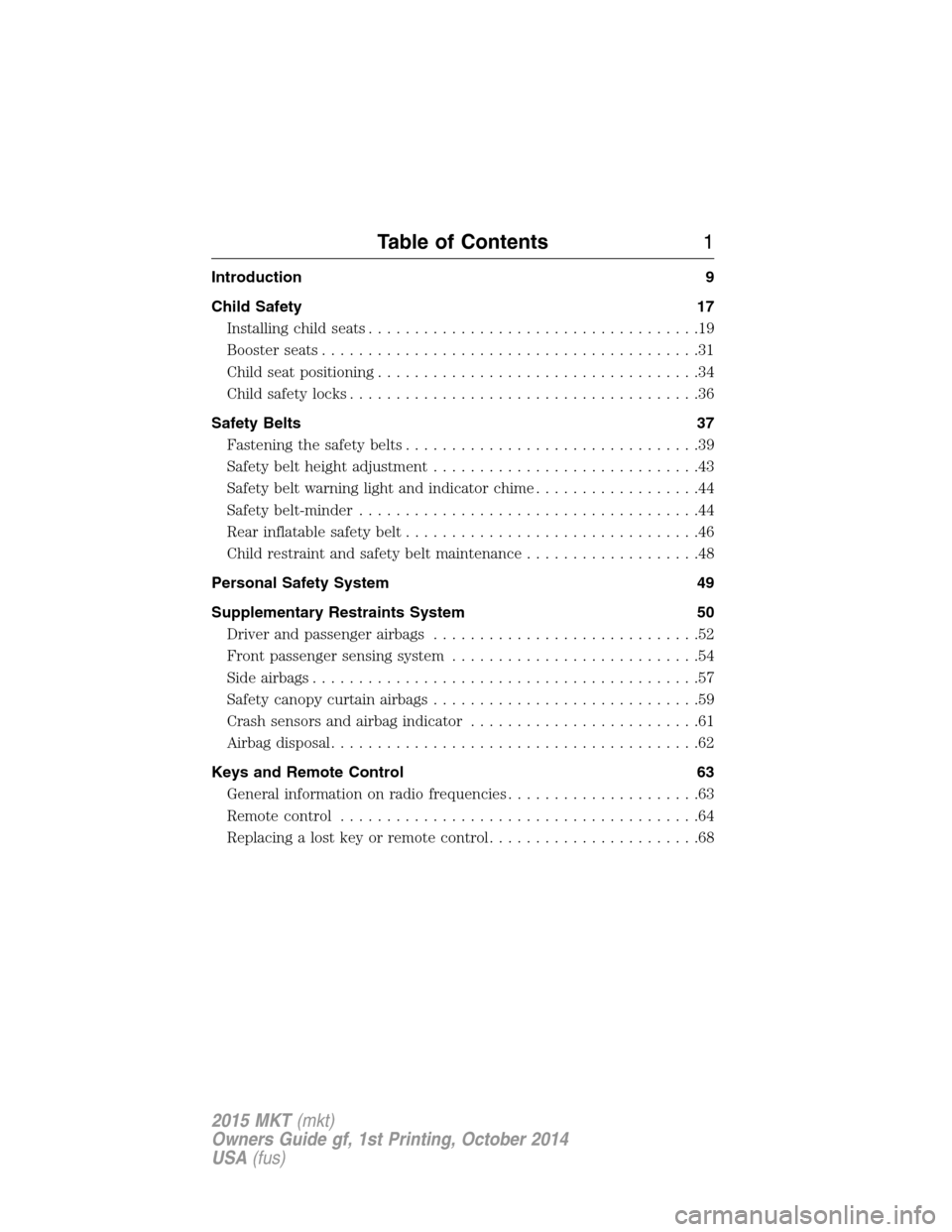
Introduction 9
Child Safety 17
Installing child seats....................................19
Booster seats.........................................31
Child seat positioning...................................34
Child safety locks......................................36
Safety Belts 37
Fastening the safety belts................................39
Safety belt height adjustment.............................43
Safetybeltwarninglightandindicatorchime..................44
Safety belt-minder.....................................44
Rear inflatable safety belt................................46
Child restraint and safety belt maintenance...................48
Personal Safety System 49
Supplementary Restraints System 50
Driver and passenger airbags.............................52
Front passenger sensing system...........................54
Side airbags..........................................57
Safety canopy curtain airbags.............................59
Crash sensors and airbag indicator.........................61
Airbag disposal........................................62
Keys and Remote Control 63
General information on radio frequencies.....................63
Remote control.......................................64
Replacing a lost key or remote control.......................68
Table of Contents1
2015 MKT(mkt)
Owners Guide gf, 1st Printing, October 2014
USA(fus)
Page 11 of 500
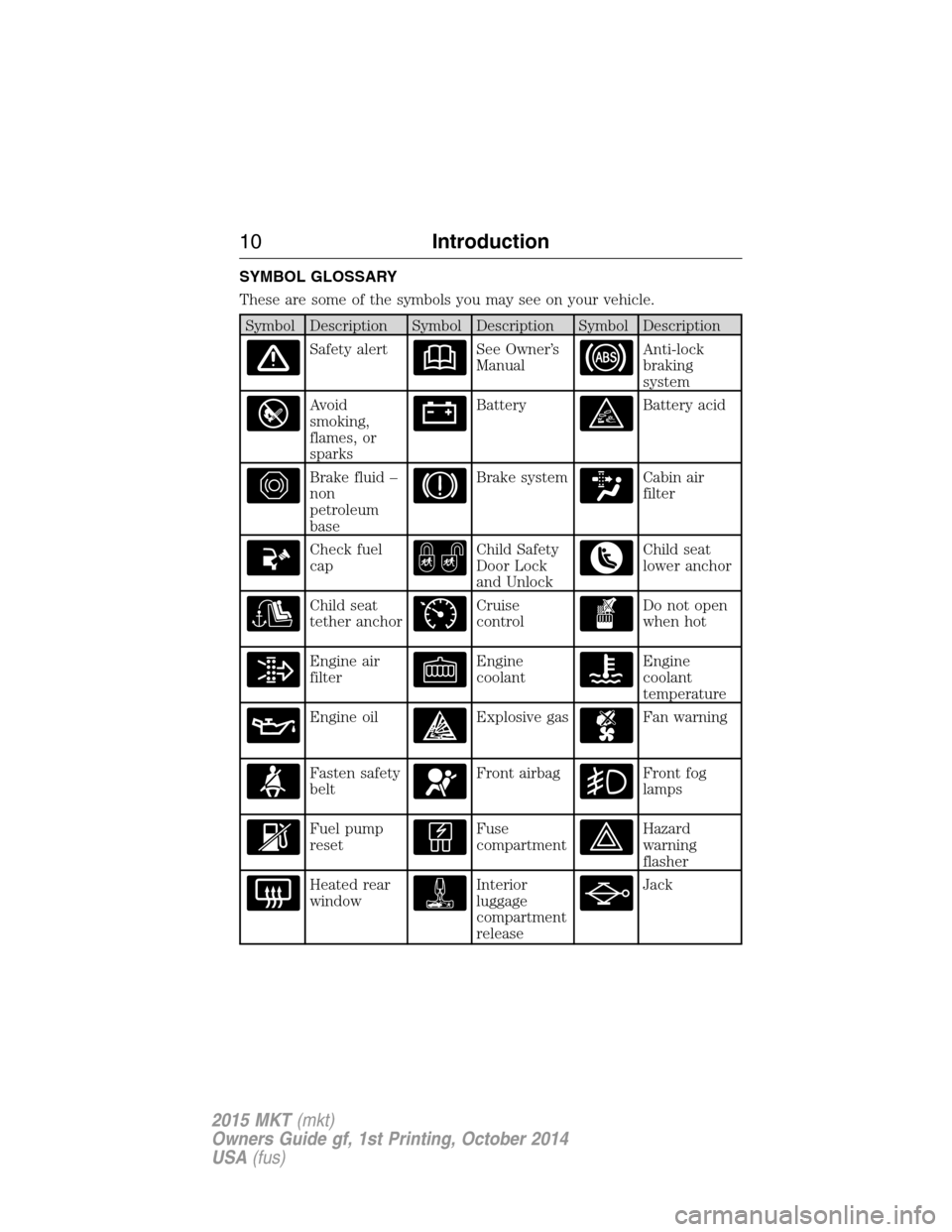
SYMBOL GLOSSARY
These are some of the symbols you may see on your vehicle.
Symbol Description Symbol Description Symbol Description
Safety alertSee Owner’s
ManualAnti-lock
braking
system
Avoid
smoking,
flames, or
sparksBatteryBattery acid
Brake fluid –
non
petroleum
baseBrake systemCabin air
filter
Check fuel
capChild Safety
Door Lock
and UnlockChild seat
lower anchor
Child seat
tether anchorCruise
controlDo not open
when hot
Engine air
filterEngine
coolantEngine
coolant
temperature
Engine oilExplosive gasFan warning
Fasten safety
beltFront airbagFront fog
lamps
Fuel pump
resetFuse
compartmentHazard
warning
flasher
Heated rear
windowInterior
luggage
compartment
releaseJack
10Introduction
2015 MKT(mkt)
Owners Guide gf, 1st Printing, October 2014
USA(fus)
Page 20 of 500
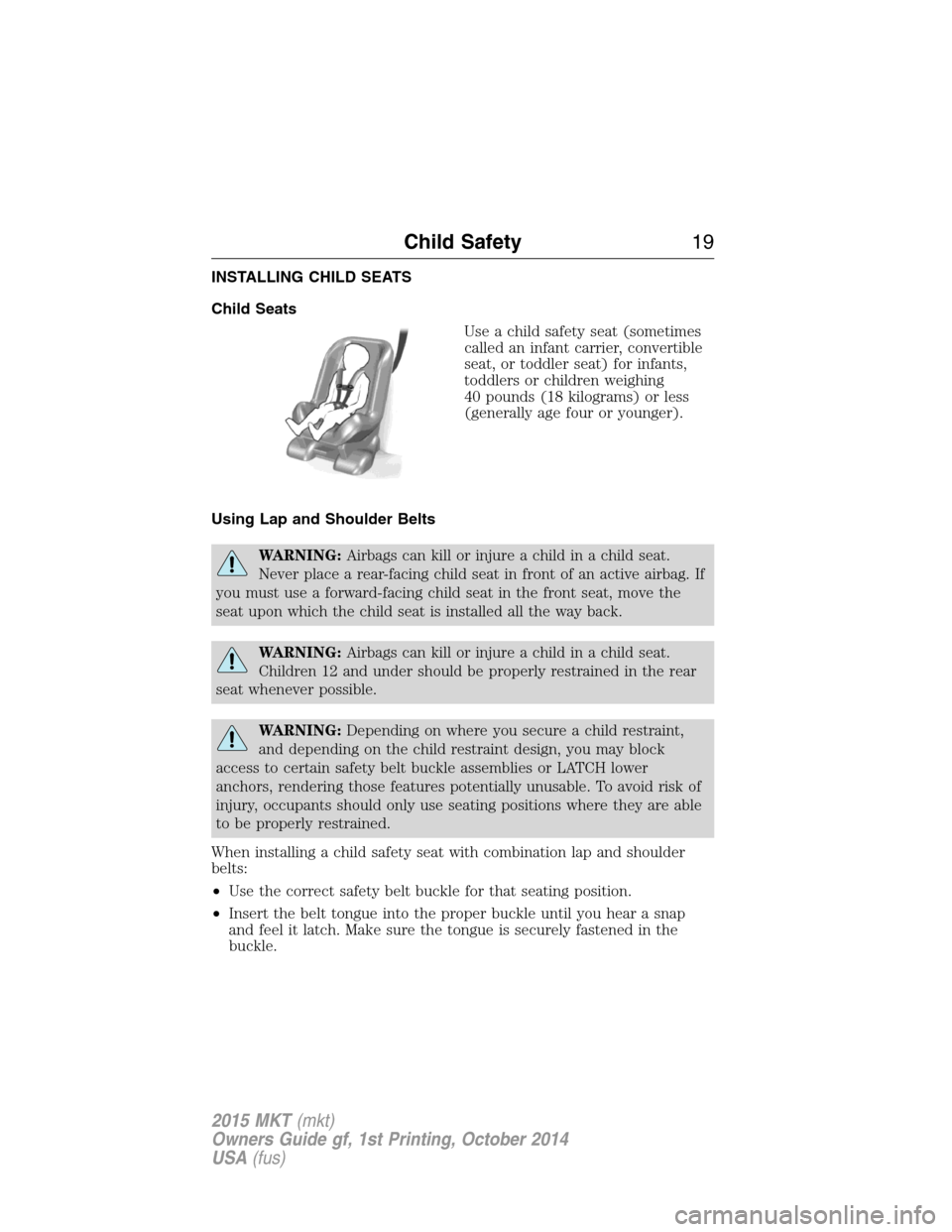
INSTALLING CHILD SEATS
Child Seats
Use a child safety seat (sometimes
called an infant carrier, convertible
seat, or toddler seat) for infants,
toddlers or children weighing
40 pounds (18 kilograms) or less
(generally age four or younger).
Using Lap and Shoulder Belts
WARNING:Airbags can kill or injure a child in a child seat.
Never place a rear-facing child seat in front of an active airbag. If
you must use a forward-facing child seat in the front seat, move the
seat upon which the child seat is installed all the way back.
WARNING:Airbags can kill or injure a child in a child seat.
Children 12 and under should be properly restrained in the rear
seat whenever possible.
WARNING:Depending on where you secure a child restraint,
and depending on the child restraint design, you may block
access to certain safety belt buckle assemblies or LATCH lower
anchors, rendering those features potentially unusable. To avoid risk of
injury, occupants should only use seating positions where they are able
to be properly restrained.
When installing a child safety seat with combination lap and shoulder
belts:
•Use the correct safety belt buckle for that seating position.
•Insert the belt tongue into the proper buckle until you hear a snap
and feel it latch. Make sure the tongue is securely fastened in the
buckle.
Child Safety19
2015 MKT(mkt)
Owners Guide gf, 1st Printing, October 2014
USA(fus)
Page 21 of 500
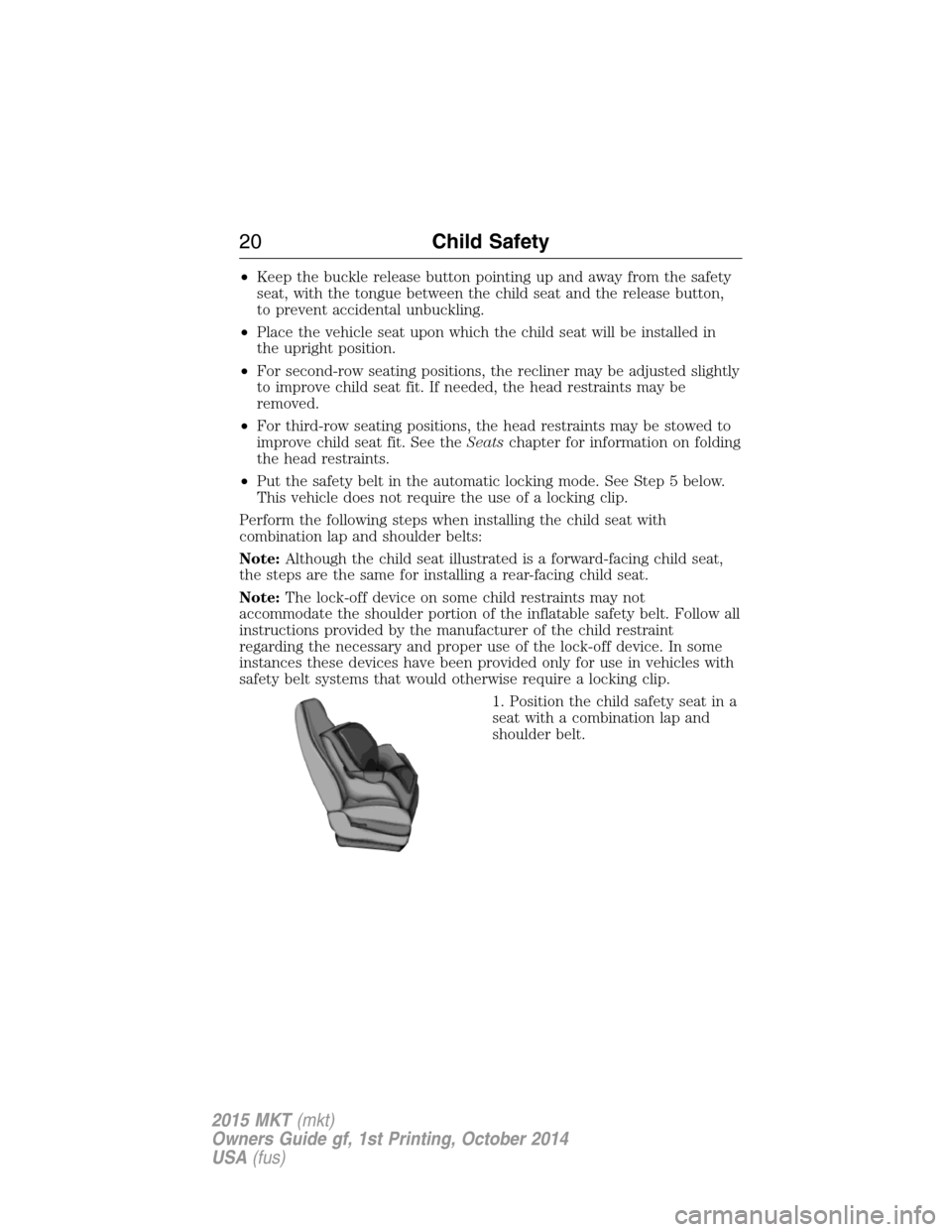
•Keep the buckle release button pointing up and away from the safety
seat, with the tongue between the child seat and the release button,
to prevent accidental unbuckling.
•Place the vehicle seat upon which the child seat will be installed in
the upright position.
•For second-row seating positions, the recliner may be adjusted slightly
to improve child seat fit. If needed, the head restraints may be
removed.
•For third-row seating positions, the head restraints may be stowed to
improve child seat fit. See theSeatschapter for information on folding
the head restraints.
•Put the safety belt in the automatic locking mode. See Step 5 below.
This vehicle does not require the use of a locking clip.
Perform the following steps when installing the child seat with
combination lap and shoulder belts:
Note:Although the child seat illustrated is a forward-facing child seat,
the steps are the same for installing a rear-facing child seat.
Note:The lock-off device on some child restraints may not
accommodate the shoulder portion of the inflatable safety belt. Follow all
instructions provided by the manufacturer of the child restraint
regarding the necessary and proper use of the lock-off device. In some
instances these devices have been provided only for use in vehicles with
safety belt systems that would otherwise require a locking clip.
1. Position the child safety seat in a
seat with a combination lap and
shoulder belt.
20Child Safety
2015 MKT(mkt)
Owners Guide gf, 1st Printing, October 2014
USA(fus)
Page 23 of 500
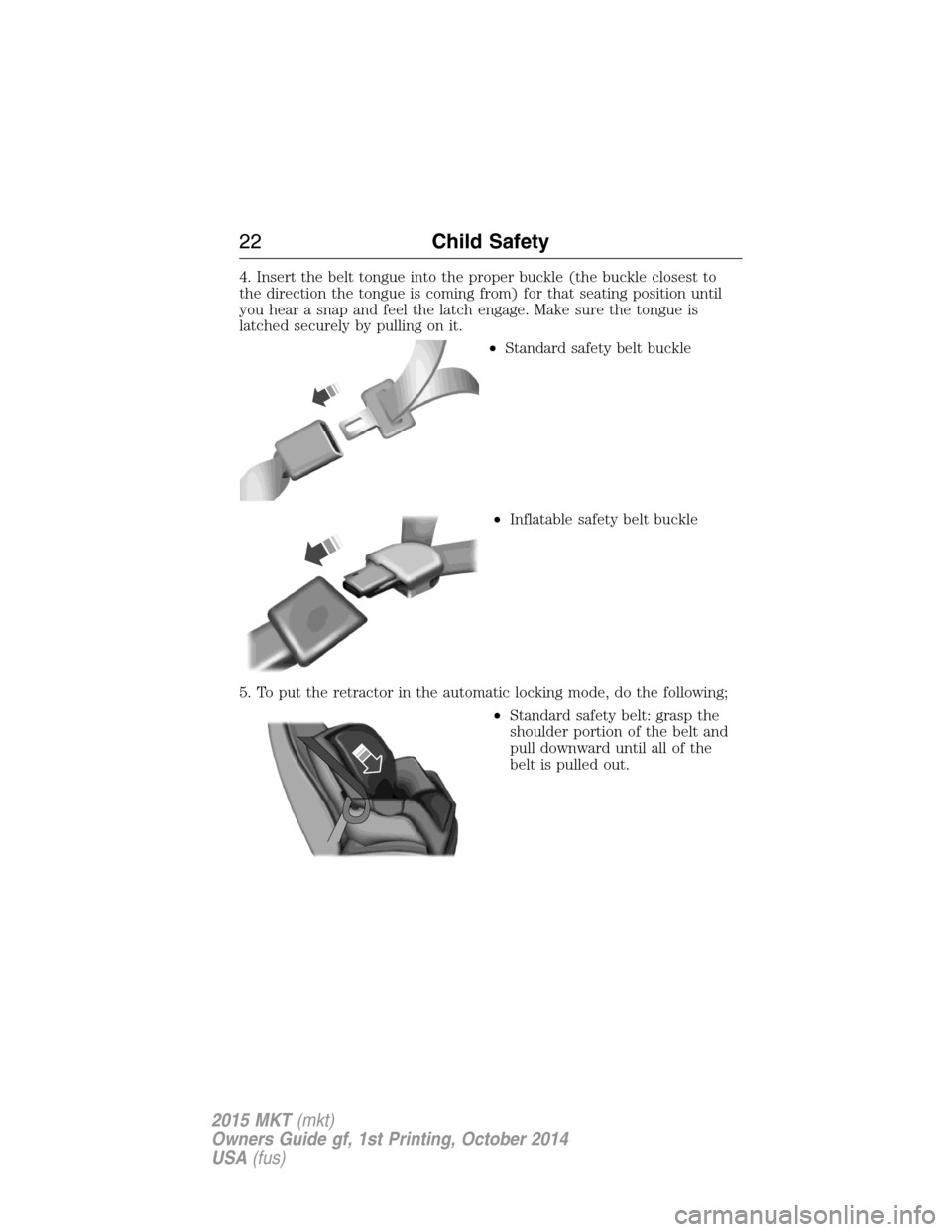
4. Insert the belt tongue into the proper buckle (the buckle closest to
the direction the tongue is coming from) for that seating position until
you hear a snap and feel the latch engage. Make sure the tongue is
latched securely by pulling on it.
•Standard safety belt buckle
•Inflatable safety belt buckle
5. To put the retractor in the automatic locking mode, do the following;
•Standard safety belt: grasp the
shoulder portion of the belt and
pull downward until all of the
belt is pulled out.
22Child Safety
2015 MKT(mkt)
Owners Guide gf, 1st Printing, October 2014
USA(fus)
Page 24 of 500
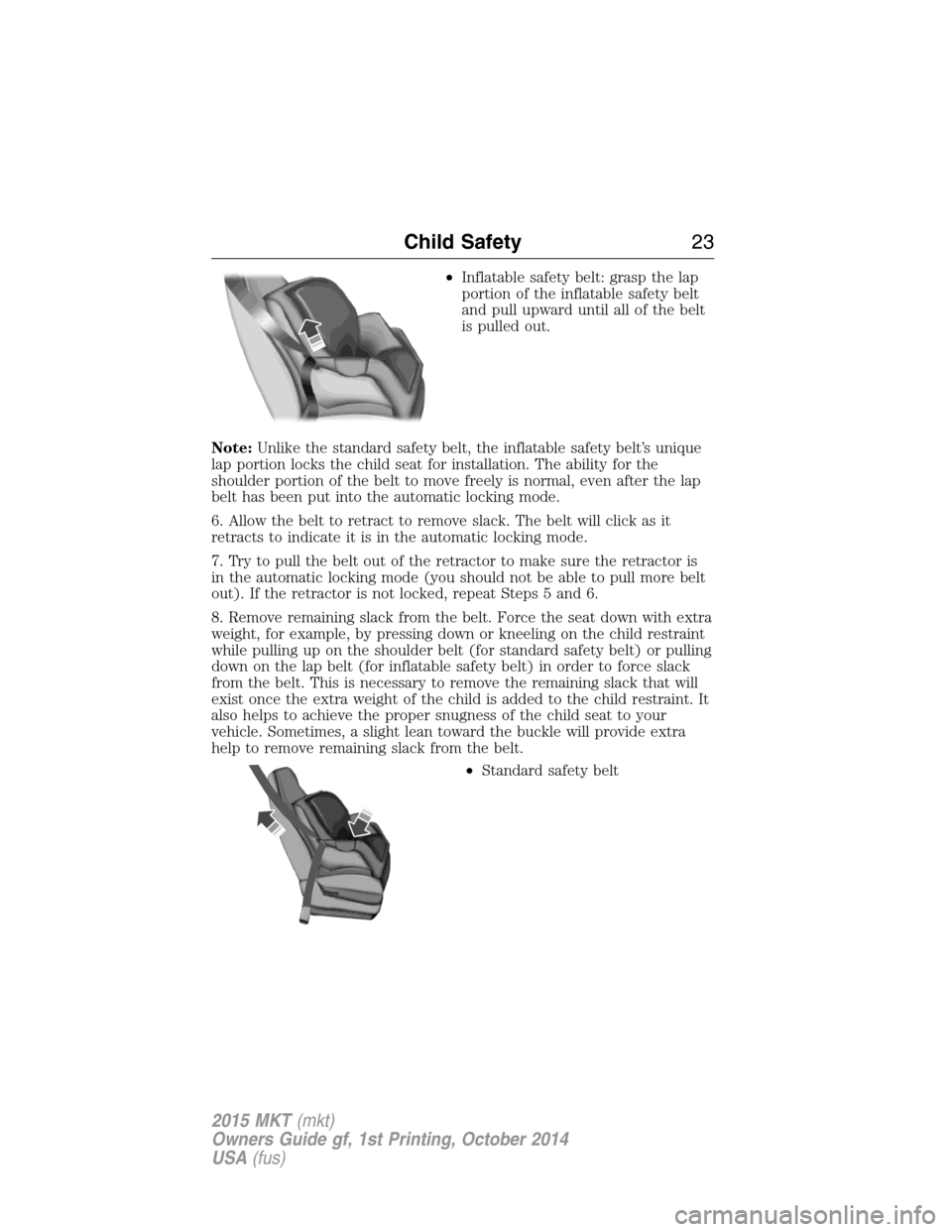
•Inflatable safety belt: grasp the lap
portion of the inflatable safety belt
and pull upward until all of the belt
is pulled out.
Note:Unlike the standard safety belt, the inflatable safety belt’s unique
lap portion locks the child seat for installation. The ability for the
shoulder portion of the belt to move freely is normal, even after the lap
belt has been put into the automatic locking mode.
6. Allow the belt to retract to remove slack. The belt will click as it
retracts to indicate it is in the automatic locking mode.
7. Try to pull the belt out of the retractor to make sure the retractor is
in the automatic locking mode (you should not be able to pull more belt
out). If the retractor is not locked, repeat Steps 5 and 6.
8. Remove remaining slack from the belt. Force the seat down with extra
weight, for example, by pressing down or kneeling on the child restraint
while pulling up on the shoulder belt (for standard safety belt) or pulling
down on the lap belt (for inflatable safety belt) in order to force slack
from the belt. This is necessary to remove the remaining slack that will
exist once the extra weight of the child is added to the child restraint. It
also helps to achieve the proper snugness of the child seat to your
vehicle. Sometimes, a slight lean toward the buckle will provide extra
help to remove remaining slack from the belt.
•Standard safety belt
Child Safety23
2015 MKT(mkt)
Owners Guide gf, 1st Printing, October 2014
USA(fus)
Page 25 of 500
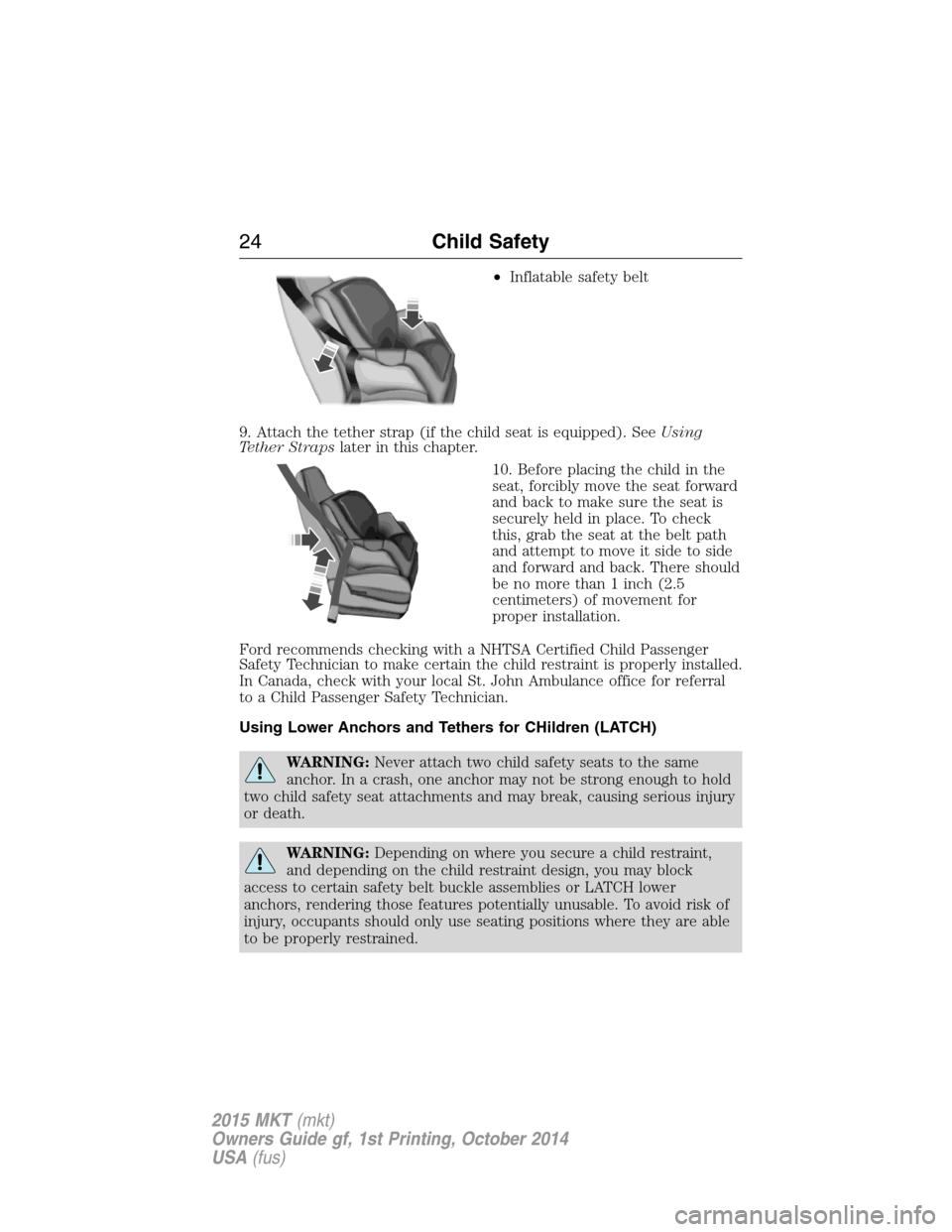
•Inflatable safety belt
9. Attach the tether strap (if the child seat is equipped). SeeUsing
Tether Strapslater in this chapter.
10. Before placing the child in the
seat, forcibly move the seat forward
and back to make sure the seat is
securely held in place. To check
this, grab the seat at the belt path
and attempt to move it side to side
and forward and back. There should
be no more than 1 inch (2.5
centimeters) of movement for
proper installation.
Ford recommends checking with a NHTSA Certified Child Passenger
Safety Technician to make certain the child restraint is properly installed.
In Canada, check with your local St. John Ambulance office for referral
to a Child Passenger Safety Technician.
Using Lower Anchors and Tethers for CHildren (LATCH)
WARNING:Never attach two child safety seats to the same
anchor. In a crash, one anchor may not be strong enough to hold
two child safety seat attachments and may break, causing serious injury
or death.
WARNING:Depending on where you secure a child restraint,
and depending on the child restraint design, you may block
access to certain safety belt buckle assemblies or LATCH lower
anchors, rendering those features potentially unusable. To avoid risk of
injury, occupants should only use seating positions where they are able
to be properly restrained.
24Child Safety
2015 MKT(mkt)
Owners Guide gf, 1st Printing, October 2014
USA(fus)
Page 37 of 500
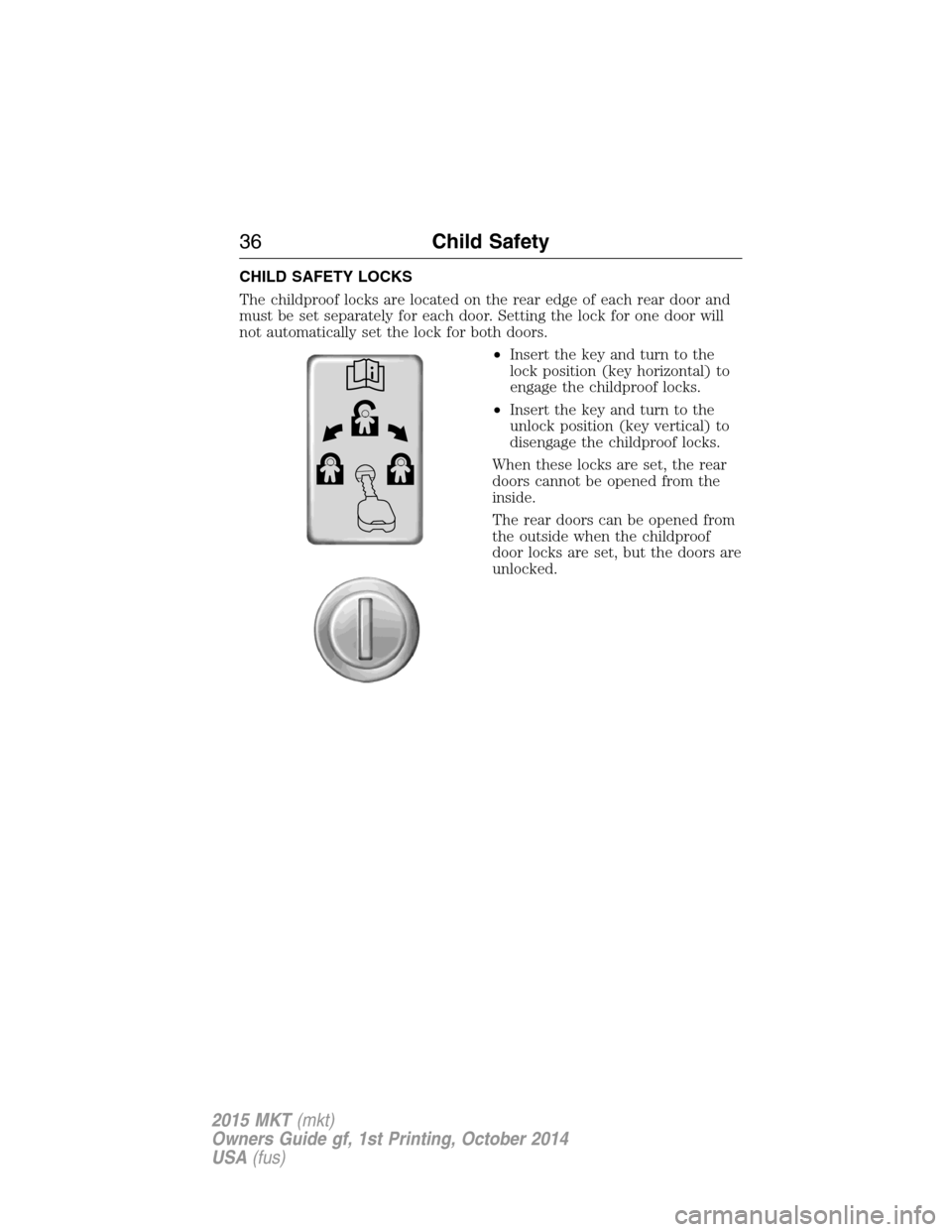
CHILD SAFETY LOCKS
The childproof locks are located on the rear edge of each rear door and
must be set separately for each door. Setting the lock for one door will
not automatically set the lock for both doors.
•Insert the key and turn to the
lock position (key horizontal) to
engage the childproof locks.
•Insert the key and turn to the
unlock position (key vertical) to
disengage the childproof locks.
When these locks are set, the rear
doors cannot be opened from the
inside.
The rear doors can be opened from
the outside when the childproof
door locks are set, but the doors are
unlocked.
36Child Safety
2015 MKT(mkt)
Owners Guide gf, 1st Printing, October 2014
USA(fus)
Page 39 of 500
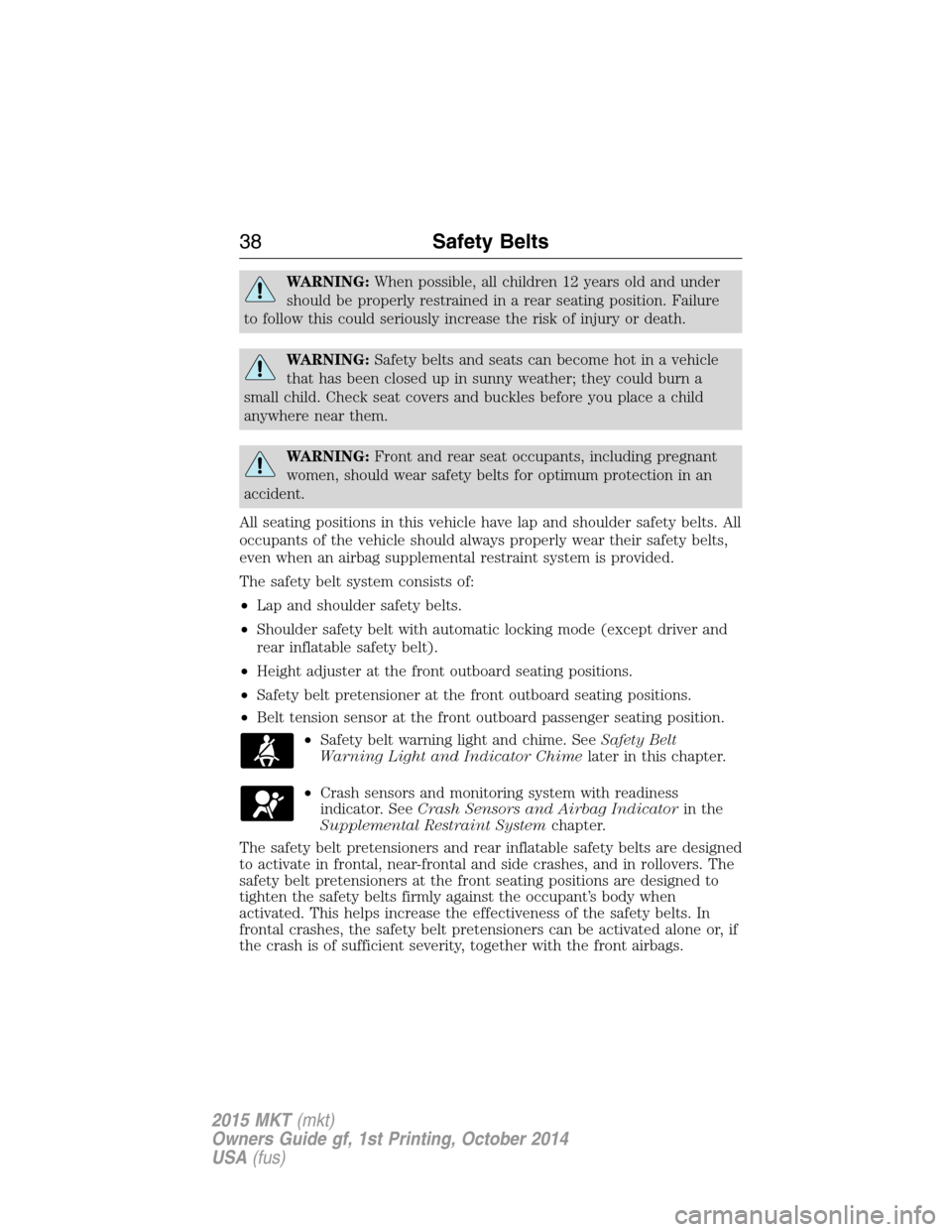
WARNING:When possible, all children 12 years old and under
should be properly restrained in a rear seating position. Failure
to follow this could seriously increase the risk of injury or death.
WARNING:Safety belts and seats can become hot in a vehicle
that has been closed up in sunny weather; they could burn a
small child. Check seat covers and buckles before you place a child
anywhere near them.
WARNING:Front and rear seat occupants, including pregnant
women, should wear safety belts for optimum protection in an
accident.
All seating positions in this vehicle have lap and shoulder safety belts. All
occupants of the vehicle should always properly wear their safety belts,
even when an airbag supplemental restraint system is provided.
The safety belt system consists of:
•Lap and shoulder safety belts.
•Shoulder safety belt with automatic locking mode (except driver and
rear inflatable safety belt).
•Height adjuster at the front outboard seating positions.
•Safety belt pretensioner at the front outboard seating positions.
•Belt tension sensor at the front outboard passenger seating position.
•Safety belt warning light and chime. SeeSafety Belt
Warning Light and Indicator Chimelater in this chapter.
•Crash sensors and monitoring system with readiness
indicator. SeeCrash Sensors and Airbag Indicatorin the
Supplemental Restraint Systemchapter.
The safety belt pretensioners and rear inflatable safety belts are designed
to activate in frontal, near-frontal and side crashes, and in rollovers. The
safety belt pretensioners at the front seating positions are designed to
tighten the safety belts firmly against the occupant’s body when
activated. This helps increase the effectiveness of the safety belts. In
frontal crashes, the safety belt pretensioners can be activated alone or, if
the crash is of sufficient severity, together with the front airbags.
38Safety Belts
2015 MKT(mkt)
Owners Guide gf, 1st Printing, October 2014
USA(fus)
Page 42 of 500
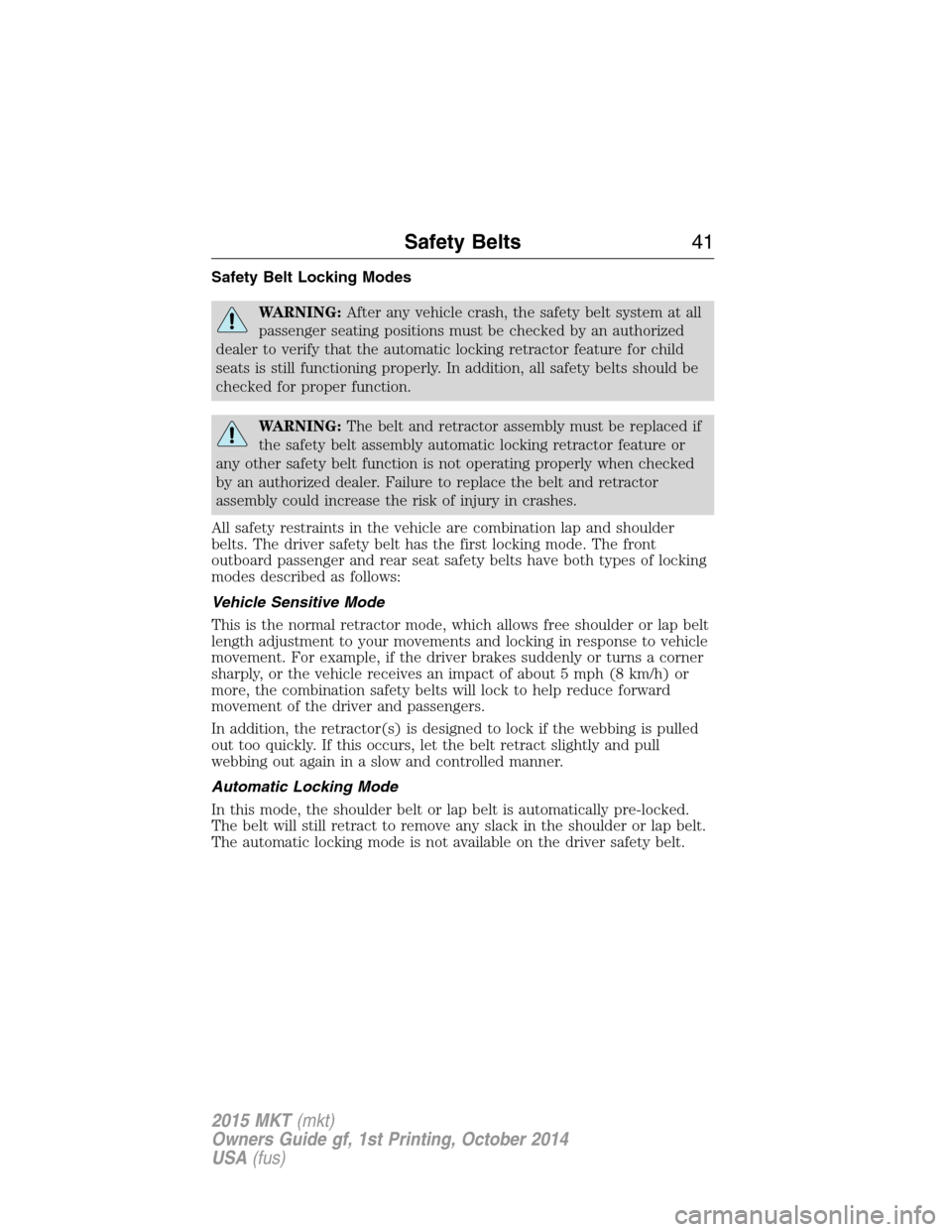
Safety Belt Locking Modes
WARNING:After any vehicle crash, the safety belt system at all
passenger seating positions must be checked by an authorized
dealer to verify that the automatic locking retractor feature for child
seats is still functioning properly. In addition, all safety belts should be
checked for proper function.
WARNING:The belt and retractor assembly must be replaced if
the safety belt assembly automatic locking retractor feature or
any other safety belt function is not operating properly when checked
by an authorized dealer. Failure to replace the belt and retractor
assembly could increase the risk of injury in crashes.
All safety restraints in the vehicle are combination lap and shoulder
belts. The driver safety belt has the first locking mode. The front
outboard passenger and rear seat safety belts have both types of locking
modes described as follows:
Vehicle Sensitive Mode
This is the normal retractor mode, which allows free shoulder or lap belt
length adjustment to your movements and locking in response to vehicle
movement. For example, if the driver brakes suddenly or turns a corner
sharply, or the vehicle receives an impact of about 5 mph (8 km/h) or
more, the combination safety belts will lock to help reduce forward
movement of the driver and passengers.
In addition, the retractor(s) is designed to lock if the webbing is pulled
out too quickly. If this occurs, let the belt retract slightly and pull
webbing out again in a slow and controlled manner.
Automatic Locking Mode
In this mode, the shoulder belt or lap belt is automatically pre-locked.
The belt will still retract to remove any slack in the shoulder or lap belt.
The automatic locking mode is not available on the driver safety belt.
Safety Belts41
2015 MKT(mkt)
Owners Guide gf, 1st Printing, October 2014
USA(fus)